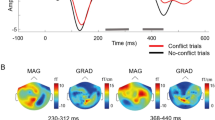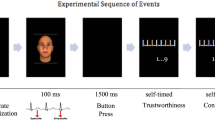Abstract
Evaluating social others requires processing complex information. Nevertheless, we can rapidly form an opinion of an individual during an initial encounter. Moreover, people can vary in these opinions, even though the same information is provided. We investigated the brain mechanisms that give rise to the impressions that are formed on meeting a new person. Neuroimaging revealed that responses in the amygdala and the posterior cingulate cortex (PCC) were stronger while encoding social information that was consistent, relative to inconsistent, with subsequent evaluations. In addition, these responses scaled parametrically with the strength of evaluations. These findings provide evidence for encoding differences on the basis of subsequent evaluations, suggesting that the amygdala and PCC are important for forming first impressions.
This is a preview of subscription content, access via your institution
Access options
Subscribe to this journal
Receive 12 print issues and online access
$209.00 per year
only $17.42 per issue
Buy this article
- Purchase on Springer Link
- Instant access to full article PDF
Prices may be subject to local taxes which are calculated during checkout




Similar content being viewed by others
References
Ambady, N. & Rosenthal, R. Half a minute: predicting teacher evaluations from thin slices of behavior and physical attractiveness. J. Pers. Soc. Psychol. 64, 431–441 (1993).
Uleman, J.S., Blader, S. & Todorov, A. Implicit impressions. in The New Unconscious (eds. Hassin, R. Uleman, J.S. & Bargh, J.A.) 362–392 (Oxford University Press, New York, 2005).
Paller, K.A., Kutas, M. & Mayes, A.R. Neural correlates of encoding in an incidental learning paradigm. Electroencephalogr. Clin. Neurophysiol. 67, 360–371 (1987).
Brewer, J.B. et al. Making memories: brain activity that predicts how well visual experience will be remembered. Science 281, 1185–1187 (1998).
Wagner, A.D. et al. Building memories: remembering and forgetting of verbal experiences as predicted by brain activity. Science 281, 1188–1191 (1998).
Mitchell, J.P., Macrae, C.N. & Banaji, M.R. Encoding-specific effects of social cognition on the neural correlates of subsequent memory. J. Neurosci. 24, 4912–4917 (2004).
Mitchell, J.P., Heatherton, T.F. & Macrae, C.N. Distinct neural systems subserve person and object knowledge. Proc. Natl. Acad. Sci. USA 99, 15238–15243 (2002).
Amodio, D.M. & Frith, C.D. Meeting of minds: the medial frontal cortex and social cognition. Nat. Rev. Neurosci. 7, 268–277 (2006).
Mitchell, J.P., Banaji, M.R. & Macrae, C.N. The link between social cognition and self-referential thought in the medial prefrontal cortex. J. Cogn. Neurosci. 17, 1306–1315 (2005).
Phelps, E.A. & LeDoux, J.E. Contributions of the amygdala to emotion processing: from animal models to human behavior. Neuron 48, 175–187 (2005).
Everitt, B.J. & Robbins, T.W. Amygdala-ventral striatal interactions and reward-related processes. in The Amygdala: Neurobiological Aspects of Emotion, Memory and Mental Dysfunction (ed. Aggleton J.P.) 401–430 (New York, Wiley-Liss, 1992).
LeDoux, J.E. Emotion circuits in the brain. Annu. Rev. Neurosci. 23, 155–184 (2000).
Engell, A.D., Haxby, J.V. & Todorov, A. Implicit trustworthiness decisions: automatic coding of face properties in the human amygdala. J. Cogn. Neurosci. 19, 1508–1519 (2007).
Winston, J.S., Strange, B.A., O'Doherty, J. & Dolan, R.J. Automatic and intentional brain responses during evaluation of trustworthiness of faces. Nat. Neurosci. 5, 277–283 (2002).
Adolphs, R., Tranel, D., Damasio, H. & Damasio, A. Impaired recognition of emotion in facial expressions following bilateral damage to the human amygdala. Nature 372, 669–672 (1994).
Adolphs, R. Recognizing emotion from facial expressions: psychological and neurological mechanisms. Behav. Cogn. Neurosci. Rev. 1, 21–62 (2002).
Hadjikhani, N. & de Gelder, B. Seeing fearful body expressions activates the fusiform cortex and amygdala. Curr. Biol. 13, 2201–2205 (2003).
Cunningham, W.A. et al. Separable neural components in the processing of black and white faces. Psychol. Sci. 15, 806–813 (2004).
Phelps, E.A. et al. Performance on indirect measures of race evaluation predicts amygdala activation. J. Cogn. Neurosci. 12, 729–738 (2000).
Asch, S.E. Forming impression of personality. J. Abnorm. Soc. Psychol. 41, 258–290 (1946).
Jones, E.E. & Goethals, G.R. Order effects in impression formation. in Attribution: Perceiving the Causes of Behavior. (eds. Jones, E.E., Kanouse, D.E., Kelley, H.H., Nisbett, R.E., Valins, S., & Weiner, B.) 27–46 (New Jersey, Lawrence Erlbaum Associates, 1987).
Anderson, N.H. & Barrios, A.A. Primacy effects in personality impression formation. J. Abnorm. Soc. Psychol. 63, 346–350 (1961).
Johnson, M.K., Kim, J.K. & Risse, G. Do alcoholic Korsakoffs syndrome patients acquire affective reactions? J. Exp. Psychol. Learn. Mem. Cogn. 11, 22–36 (1985).
Lieberman, M.D., Ochsner, K.N., Gilbert, D.T. & Schacter, D.L. Do amnesics exhibit cognitive dissonance reduction? The role of explicit memory and attention in attitude change. Psychol. Sci. 12, 135–140 (2001).
Hastie, R. & Park, B. The relationship between memory and judgment depends on whether the judgment task is memory-based or on-line. Psychol. Rev. 93, 258–268 (1986).
Somerville, L.H., Wig, G.S., Whalen, P.J. & Kelley, W.M. Dissociable medial temporal lobe contributions to social memory. J. Cogn. Neurosci. 18, 1253–1265 (2006).
Frith, C.D. The social brain? Philos. Trans. R. Soc. Lond. B Biol. Sci. 362, 671–678 (2007).
Heberlein, A.S. & Adolphs, R. Impaired spontaneous anthropomorphizing despite intact perception and social knowledge. Proc. Natl. Acad. Sci. USA 101, 7487–7491 (2004).
Kim, H. et al. Contextual modulation of amygdala responsivity to surprised faces. J. Cogn. Neurosci. 16, 1730–1745 (2004).
Cunningham, W.A., Van Bavel, J.J. & Johnsen, I.R. Affective flexibility: evaluative processing goals shape amygdala activity. Psychol. Sci. 19, 152–160 (2008).
Todorov, A., Baron, S.G. & Oosterhof, N.N. Evaluating face trustworthiness: a model-based approach. Soc. Cogn. Affect. Neurosci. 3, 119–127 (2008).
Fletcher, P.C. et al. Other minds in the brain: a functional imaging study of “theory of mind” in story comprehension. Cognition 57, 109–128 (1995).
Johnson, M.K. et al. Dissociating medial frontal and posterior cingulate activity during self-reflection. Soc. Cogn. Affect. Neurosci. 1, 56–64 (2006).
Maddock, R.J., Garrett, A.S. & Buonocore, M.H. Remembering familiar people: the posterior cingulate cortex and autobiographical memory retrieval. Neuroscience 104, 667–676 (2001).
Maddock, R.J., Garrett, A.S. & Buonocore, M.H. Posterior cingulate cortex activation by emotional words: fMRI evidence from a valence decision task. Hum. Brain Mapp. 18, 30–41 (2003).
Pessoa, L. & Padmala, S. Quantitative prediction of perceptual decisions during near-threshold fear detection. Proc. Natl. Acad. Sci. USA 102, 5612–5617 (2005).
Kable, J.W. & Glimcher, P.W. The neural correlates of subjective value during intertemporal choice. Nat. Neurosci. 10, 1625–1633 (2007).
McCoy, A.N. & Platt, M.L. Risk-sensitive neurons in the macaque cingulate cortex. Nat. Neurosci. 8, 1220–1227 (2005).
Tomlin, D. et al. Agent-specific responses in the cingulate cortex during economic exchanges. Science 312, 1047–1050 (2006).
Taber, K.H., Wen, C., Khan, A. & Hurley, R.A. The limbic thalamus. J. Neuropsychiatry Clin. Neurosci. 16, 127–132 (2004).
O'Doherty, J.P. Reward representations and reward-related learning in the human brain: insights from neuroimaging. Curr. Opin. Neurobiol. 14, 769–776 (2004).
Schiller, D., Levy, I., Niv, Y., LeDoux, J.E. & Phelps, E.A. From fear to safety and back—reversal of fear in the human brain. J. Neurosci. 28, 11517–11525 (2008).
Delgado, M.R., Li, J., Schiller, D. & Phelps, E.A. The role of striatum in aversive learning and aversive prediction errors. Phil. Trans. R. Soc. Lond. B 363, 3787–3800 (2008).
Seymour, B. & McClure, S.M. Anchors, scales and the relative coding of value in the brain. Curr. Opin. Neurobiol. 18, 173–178 (2008).
Knutson, B., Rick, S., Wimmer, G.E., Prelec, D. & Loewnstein, G. Neural predictors of purchases. Neuron 53, 147–156 (2007).
Talairach, J. & Tournoux, P. Co-planar Stereotaxic Atlas of the Human Brain: an Approach to Medical Cerebral Imaging (Thieme, New York, 1988).
Forman, S.D. et al. Improved assessment of significant activation in functional magnetic resonance imaging (fMRI): use of a cluster-size threshold. Magn. Reson. Med. 33, 636–647 (1995).
Acknowledgements
We thank I. Levy and D. Amodio for fruitful discussions and comments, C. Raio for assistance with data collection, and K. Sanzenbach and the Center for Brain Imaging at New York University for technical assistance. This study was funded by a Seaver Foundation grant to the Center for Brain Imaging, a James S. McDonnell Foundation grant to E.A.P. and a Fulbright award to D.S.
Author information
Authors and Affiliations
Contributions
D.S. designed the experiments, collected and analyzed data, interpreted the data, and wrote the first draft of the manuscript. J.B.F. contributed to data collection, analysis and interpretation, and the final version of the manuscript. J.P.M., J.S.U. and E.A.P. contributed to experimental design, data interpretation and the final version of the manuscript.
Corresponding authors
Supplementary information
Supplementary Text and Figures
Supplementary Figures 1 and 2, Supplementary Tables 1 and 2, and Supplementary Results (PDF 520 kb)
Rights and permissions
About this article
Cite this article
Schiller, D., Freeman, J., Mitchell, J. et al. A neural mechanism of first impressions. Nat Neurosci 12, 508–514 (2009). https://doi.org/10.1038/nn.2278
Received:
Accepted:
Published:
Issue Date:
DOI: https://doi.org/10.1038/nn.2278
This article is cited by
-
Exploring the relationships between first impressions and MMI ratings: a pilot study
Advances in Health Sciences Education (2023)
-
Saliency at first sight: instant identity referential advantage toward a newly met partner
Cognitive Research: Principles and Implications (2019)
-
Neural representations of Groups and Stereotypes using fMRI repetition suppression
Scientific Reports (2019)
-
Pervasive influence of idiosyncratic associative biases during facial emotion recognition
Scientific Reports (2018)



